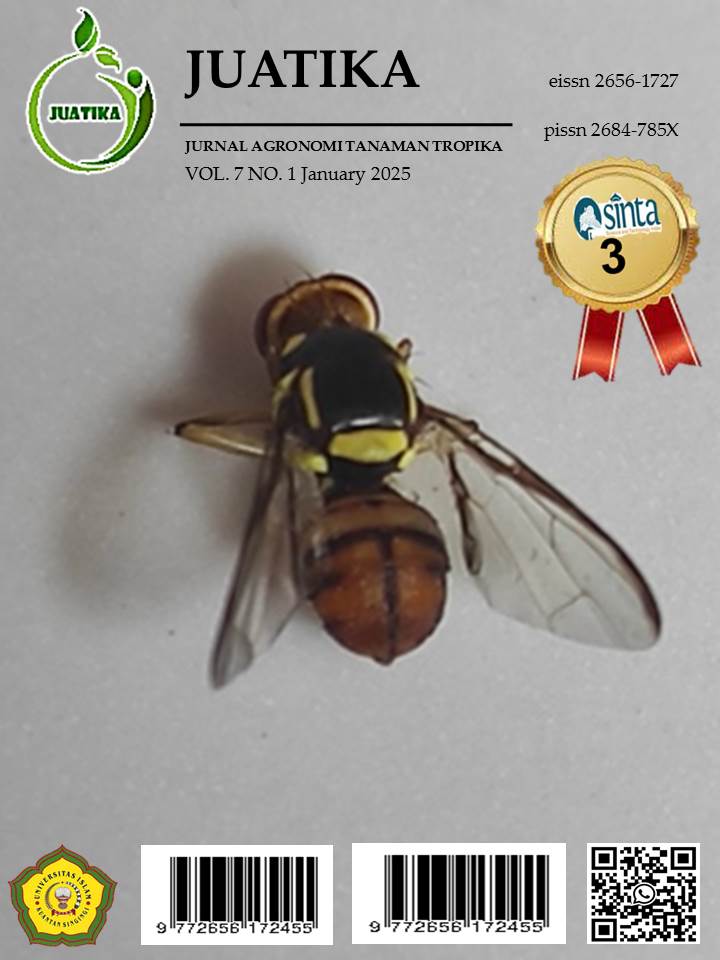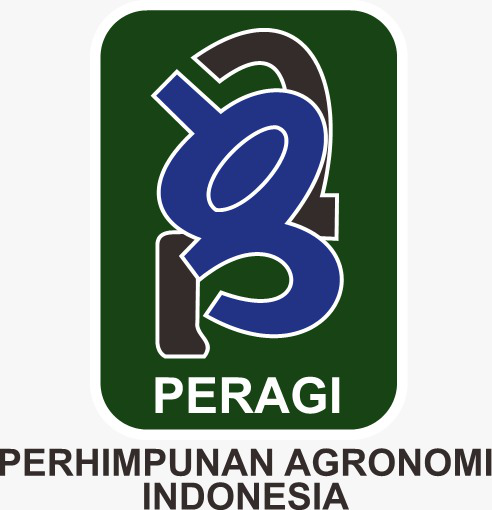The Effectiveness of Planting based on The Number of Seeds in Increasing The Adaptability and Productivity of Sweet Corn
Abstract
This study aimed to evaluate the influence of the number of seeds per planting hole on the productivity and adaptability of sweet corn varieties. Using a nested research design, eight Indonesian commercial sweetcorn varieties were tested with variations in the number of seeds per planting hole. Results showed that plant height ranged from 144.86 cm to 191.66 cm, with the BN 44 variety having the highest height. However, seed number treatment did not significantly affect plant height, stem diameter, or leaf count. Meanwhile, the highest productivity is achieved by the Talenta and Bonanza 9 F1 varieties at the treatment of one seed per hole, as well as the Prima variety at the treatment of two seeds. These findings emphasize the importance of variety selection in the management of sweet corn cultivation and show that although seed numbers are insignificant, the right variety can improve crop yields. The implications of this research are important for the development of sustainable and efficient agricultural strategies and can contribute to food security through increased sweet corn productivity.
Downloads
References
Alotaibi, M. (2023). Climate change, its impact on crop production, challenges, and possible solutions. Notulae Botanicae Horti Agrobotanici Cluj-Napoca, 51(1), 1–39. https://doi.org/10.15835/nbha51113020
Asrijal, A., Sapareng, S., Upe, A., Akmal, A., & Arzan AR, T. S. (2023). Testing of plant growth regulator and organic fertilizers on black rice plants. Jurnal Teknik Pertanian Lampung (Journal of Agricultural Engineering, 12(2), 484–494. https://doi.org/10.23960/jtep-l.v12i2.484-494
Chen, D., Wang, S., Cao, B., Cao, D., Leng, G., Li, H., Yin, L., Shan, L., & Deng, X. (2016). Genotypic variation in growth and physiological response to drought stress and re-watering reveals the critical role of recovery in drought adaptation in maize seedlings. Frontiers in Plant Science, 6(JAN2016), 1–15. https://doi.org/10.3389/fpls.2015.01241
Chen, S., Dang, D., Liu, Y., Ji, S., Zheng, H., Zhao, C., Dong, X., Li, C., Guan, Y., Zhang, A., & Ruan, Y. (2023). Genome-wide association study presents insights into the genetic architecture of drought tolerance in maize seedlings under field water-deficit conditions. Frontiers in Plant Science, 14(May), 1–18. https://doi.org/10.3389/fpls.2023.1165582
Da Costa, J. C., Almeida, A. R. de, Silva, M. R. B. da, Santos, J. C. S. dos, Leite, A. da S., & Junior, N. C. de L. (2019). Genetic parameters in the initial phase of collaborative plant breeding in lima beans (Phaseolus lunatus). Journal of Experimental Agriculture International, 36(6), 1–6. https://doi.org/10.9734/jeai/2019/v36i630250
Dadlani, M., & Yadava, D. K. (2023). Seed science and technology: Biology, production, quality. https://doi.org/10.1007/978-981-19-5888-5
Dang, D., Guan, Y., Zheng, H., Zhang, X., Zhang, A., Wang, H., Ruan, Y., & Qin, L. (2023). Genome-wide association study and genomic prediction on plant architecture traits in sweet corn and waxy corn. Plants, 12(2), 1–17. https://doi.org/10.3390/plants12020303
De Swaef, T., De Schepper, V., Vandegehuchte, M. W., & Steppe, K. (2015). Stem diameter variations as a versatile research tool in ecophysiology. Tree Physiology, 35(10), 1047–1061. https://doi.org/10.1093/treephys/tpv080
Huang, M., Wang, J., Wang, B., Liu, D. L., Feng, P., Yu, Q., Pan, X., & Waters, C. (2021). Assessing maize potential to mitigate the adverse effects of future rising temperature and heat stress in China. Agricultural and Forest Meteorology, 311(October), 108673. https://doi.org/10.1016/j.agrformet.2021.108673
Igea, J., Miller, E. F., Papadopulos, A. S. T., & Tanentzap, A. J. (2017). Seed size and its rate of evolution correlate with species diversification across angiosperms. PLOS Biology, 15(7), 1–16. https://doi.org/10.1371/journal.pbio.2002792
Kumar, S., Singh, R., & Singh, A. K. (2022). Impact of different spacing on production of pole type lima bean (Phaseolus lunatus L.) with intercropping of brinjal crop. International Journal of Advanced Chemistry Research, 4(2), 159–162. https://doi.org/10.33545/26646781.2022.v4.i2c.93
Khmelnychyi, L. M. (2022). Influence of genetic factors on indicators lifetime productivity of dairy cattle. Тваринництво Степу України, 1(2), 26–36.
Lázaro, A., & Larrinaga, A. R. (2018). A multi-level test of the seed number/size trade-off in two Scandinavian communities. PLOS ONE, 13(7), 1–20. https://doi.org/10.1371/journal.pone.0201175
Pardo-Giménez, A., Pardo, J. E., Dias, E. S., Rinker, D. L., Caitano, C. E. C., & Zied, D. C. (2020). Optimization of cultivation techniques improves the agronomic behavior of Agaricus subrufescens. Scientific Reports, 10(1), 1–9. https://doi.org/10.1038/s41598-020-65081-2
Pártay, L. B., Bartók, A. P., & Csányi, G. (2014). Nested sampling for materials: The case of hard spheres. Physical Review E - Statistical, Nonlinear, and Soft Matter Physics, 89(2). https://doi.org/10.1103/PhysRevE.89.022302
Rasheed, A., Jie, H., Ali, B., He, P., Zhao, L., Ma, Y., Xing, H., Qari, S. H., Hassan, M. U., Hamid, M. R., & Jie, Y. (2023). Breeding drought-tolerant maize (Zea mays) using molecular breeding tools: Recent advancements and future prospective. Agronomy, 13(6), 1–21. https://doi.org/10.3390/agronomy13061459
Sapareng, S., Idris, M. Y., Akbar, T. W., Taruna, A. R., & Arzam, S. (2017). Pengaruh media tanah dan beberapa jenis pupuk organik terhadap pertumbuhan dan produksi tanaman jagung. Jurnal Agrosains dan Teknologi, 2(1), 43–50.
Septiani Sinaga, N., Andriani Luta, D., & Riah Ate Tarigan, R. (2023). Increasing the growth and production of sweet corn (Zea mays saccharata) by giving chicken manure and vegetable waste liquid organic fertilizer. Jurnal Agronomi Tanaman Tropika (Juatika), 5(2), 322–329. https://doi.org/10.36378/juatika.v5i2.3111
Stein, M., Miguez, F., & Edwards, J. (2016). Effects of plant density on plant growth before and after recurrent selection in maize. Crop Science, 56(6), 2882–2894. https://doi.org/10.2135/cropsci2015.09.0599
Wang, J., Hu, Z., Upadhyaya, H. D., & Morris, G. P. (2020). Genomic signatures of seed mass adaptation to global precipitation gradients in sorghum. Heredity, 124(1), 108–121. https://doi.org/10.1038/s41437-019-0249-4
Hadianto, W., et al. (2024). The effect of artificial crossing on the yield of several corn varieties (Zea mays L.). Jurnal Agronomi Tanaman Tropika (JUATIKA), 6(3), 923–930. https://doi.org/10.36378/juatika.v6i3.3812
Copyright (c) 2025 Sukriming Sapareng

This work is licensed under a Creative Commons Attribution 4.0 International License.
Authors who publish with Jurnal Agronomi Tanaman Tropika (JUATIKA) agree to the following terms:
Authors retain copyright and grant the Jurnal Agronomi Tanaman Tropika (JUATIKA) right of first publication with the work simultaneously licensed under a Creative Commons Attribution License (CC BY 4.0) that allows others to share (copy and redistribute the material in any medium or format) and adapt (remix, transform, and build upon the material for any purpose, even commercially) with an acknowledgment of the work's authorship and initial publication in Jurnal Agronomi Tanaman Tropika (JUATIKA).
Authors are able to enter into separate, additional contractual arrangements for the non-exclusive distribution of the journal's published version of the work (e.g., post it to an institutional repository or publish it in a book), with an acknowledgment of its initial publication in Jurnal Agronomi Tanaman Tropika (JUATIKA). Authors are permitted and encouraged to post their work online (e.g., in institutional repositories or on their website) prior to and during the submission process, as it can lead to productive exchanges, as well as earlier and greater citation of published work.







 More Information
More Information



